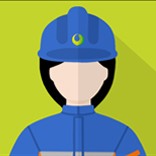Can’t get your casing to the planned depth? Get the best casing scenario with ESET™-An Enhanced SET® System.
Increasing the operating envelope of Solid Expandable Tubulars
Ledging, highly deviated, long-reach, and equally challenging well geometries can stop conventional expandable liner runs short of the target setting depth.
Enventure, a leader in expandable technologies, developed the ESET system, the industry’s only solid expandable liner that can be rotated and reciprocated to help operators meet their objectives, reduce non-productive time (NPT) and elevate the value of high-cost assets.
The high-torque ESET rotational liner allows you to break friction to reduce NPT and efficiently work to the targeted setting depth in highly deviated and tortuous well paths. The ESET can also be rotated once at the setting depth to improve cementation of the expandable liner ensuring the best possible cement job and effective isolation of the openhole section.
Typically, the ESET system is tripped in the hole conventionally and only begins circulation and rotation to confront ledges, dips and other wellbore tortuosity issues. Unlike a standard non-rotational SET® solid expandable liner where the progress can be halted when encountering a ledge or increased friction in tortuous extended wellbores, the ESET simply rotates across the ledge or out of the well cavity and continues toward targeted depth. Wellbore clean-up will be improved with the ability to rotate to help deliver a clean wellbore for expansion.
The ESET™ Advantage
1.Minimizes NPT risks, by allowing the liner to be rotated across ledges and through tortuous wellbores
2.Increases probability of reaching setting depth
3.Enhances quality of cement job
4.Reduces costs
5.Optimizes asset value
The re-designed expansion assembly and high-torque connections combine to make ESET the most robust solid expandable liner on the market and the only one capable of being rotated and reciprocated.
1.Enventure engineered high-torque expandable connections specifically to accommodate the different sizes and weights of the ESET expandable liner suite. In high-angle and long-reach wellbores, these connections enable rotation of the liner and minimize the risk of connection back-off or connection make-up down hole, either of which could lead to pressure losses while expanding the liner.
2.We modified the launcher inner string to handle the increased torque, by removing the set screws, reducing the number of components and increasing the make-up torque of the internal connections. The launcher and inner-string components have been tested to 40,000ft/lb of torque.
3.An eccentric guide nose on the ESET liner will help to guide the tool over ledges in the wellbore.
When your application calls for even more durability and flexibility, we offer optional components for ESET to address your specific objectives and issues, including:
1.Proprietary and sacrificial tungsten carbide OD coating further protects the pipe and eliminates the risk of scoring.
2.Solid blade centralizers can be used to decrease the liners contact with the wellbore to decrease the drag on the liner.
Case Study
When:July, 2015
Location:Norwegian North Sea
Well Type:Development (Platform)
Base Casing:10-3/4 in. 55.5 lb/ft
System:8-5/8 in. ESET HP
Depth:17,750 ft
System length:1,881 ft
Wellbore Inclination:69°
Challenge
A major operator in the Norwegian North Sea anticipated problems while drilling a 12-¼ x 13-½ in. hole section which required setting 10-¾ in. casing early. This left a section of overburden exposed above the reservoir. Conventional practice would utilize a 7-5/8 in. liner to isolate the overburden and 5-½ in. pipe across the reservoir, greatly reducing production capability and return on investment (ROI).
Added Value
The 8-5/8 in. ESET HP System isolated the overburden section, providing an 8-1/2 in. drift ID. This enabled the reservoir to be drilled and completed with a 7-5/8 in. liner, maximizing production capability.
The 8-5/8 in. ESET HP System provided:
• Rotational capability that enabled the system to reach the planned setting depth and improved cementation of the liner.
• Solid Blade centralization that reduced drag while running the liner and optimized cementation.
• Bottom up expansion ensured the entire overburden was isolated.
• Increased yield and collapse values.


 石油圈
石油圈
